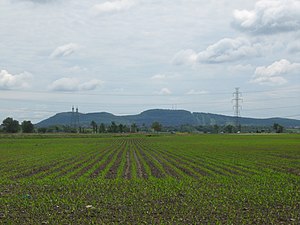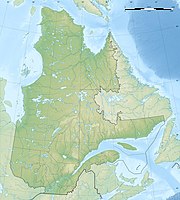Parc national du Mont-Saint-Bruno
|
Parc national du Mont-Saint-Bruno
|
||
|
The eponymous mountain |
||
| location | Quebec , Canada | |
| surface | 8.84 km² | |
| WDPA ID | 61599 | |
| Geographical location | 45 ° 33 ′ N , 73 ° 19 ′ W | |
|
|
||
| Setup date | 1985 | |
| administration | Parcs Québec, SEPAQ | |
The Parc national du Mont-Saint-Bruno is one of the currently 27 national parks in the Canadian province of Québec . There, a corresponding Parc national but what in the other provinces and territories a provincial park ( Provincial Park is). The park is operated by Sépaq ( French Société des établissements de plein air du Québec or English Society of outdoor recreation establishments of Quebec ).
The park covers the area of the 218 m high Mont Saint-Bruno , which rises about 20 km east of Montreal and belongs to the Montérégie hills . The municipality of Saint-Bruno-de-Montarville lies on its southwest flank . The task of the park, which was set up in 1985 and only measures 8.84 km², is on the one hand to protect the rich flora and fauna of the mountain, on the other hand it was the center of the Seigneurie de Montarville , a manorial rule from the French colonial era, awarded in 1710 . One of the watermills from that period, the Saint-Bruno-de-Montarville watermill from 1725, still exists today.
history
It is assumed that the region was first settled around 8,000 years ago, but there is currently no archaeological evidence. The Saint Lawrence Iroquois lived here before the first Europeans, but they disappeared around 1580.
In 1710 the mountain became part of the manorial estate given to Pierre Boucher. Boucher was lord of the neighboring Seigneurie de Boucherville . The land remained untouched until 1740. Between 1725 and 1816, in contrast to the neighboring manors, the seigneurie did not rely on windmills, but on water mills. These were used for grinding grain, but also for milling laundry, sawing wood, etc. The only remaining mill is a grain mill from 1725.
In 1825 the Boucher family sold their Seigneurie to the Montreal lawyer François-Pierre Bruneau. In 1851 she took over his cousin Olivier-Théophile. In 1897, the wealthy banker Edson Loy Pease bought part of the mountain, namely 406 hectares, which he sold two years later to the Mount Bruno Association, which he chaired himself. She built luxurious hostels there, including that of Pease on Lac du Moulin, which burned down in 1941. With the dissolution of the manors, the area became accessible to the general public. The Frères du Saint-Esprit, founded in 1715 (they changed their name to Frères de l'instruction chrétienne de Saint Gabriel in 1910 ) built one of their houses and an arboretum here . Also bought Jesuits , Trinitarians and Congregation of the Sacred Hearts of Jesus and Mary land in the area in order to be able to retreat from the troubled Montreal life. The Saint-Gabriel brothers bought the lion's share, including the Jesuit house Villa Grand-Coteau in 1912. They produced milk and apples there. In 1976 they sold the area to the province, which set up the park in 1985.
Flora and fauna
The small park is located in the Basses-terres du Saint-Laurent ecoregion. Its mild climate in southern Canada offers mixed forests with sugar maple , yellow birch , Canadian hemlock or Weymouth pine suitable locations. A total of exactly 574 plant species were recorded in 2010, which corresponds to about a fifth of the species in the entire province, 24 of which are threatened.
38 species of mammals inhabit the small area. This includes the white-tailed deer , but also small mammals such as Tamias striatus , gray squirrels , white-footed mice , woodchucks , the bat species Lasionycteris noctivagans , Lasiurus cinereus and Lasiurus borealis . In addition, there are 234 species of birds, which corresponds to 72% of the species represented in Québec, then 7 reptile, 14 amphibian and 13 fish species.
See also
literature
- The research scientifique dans les Parcs nationaux québécois. Priorités et potentiels de recherche , published by Parcs Québec and Sépaq, undated, pp. 99-107.
Web links
- Parc national du Mont-Saint-Bruno , Sépaq (French)




